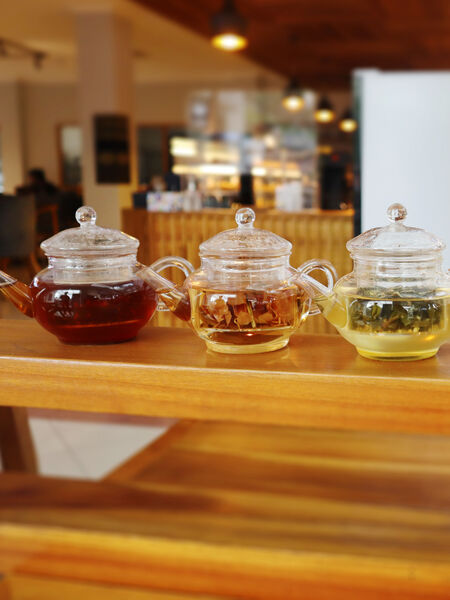How To Succeed in Tea
To be successful in tea, you need to pick a customer and rock their world. It can be hard to tell the difference between a business strategy that will make you king of a niche and one that will leave you floundering in a sea of competition. Still, it's often little differentiators that make all the difference to a company's long-term success.
The number of tea businesses that are trying to be all things to all people is appalling. Mission statements like "appealing to the casual tea drinker without alienating the connoisseur" set up impossible business challenges. Imagine trying to sell $18,000 economy cars on the same lot as $180,000 luxury sedans. Do you invest in leather chairs? Are the floors Italian marble? Do your salespeople wear expensive suits? Is the music Beethoven's or Katy Perry's? If you try to cater to both customers, you'll fail to make either happy. There's a decent chance both will be uncomfortable.
If you have a great location and a beautiful store, you'll get a ton of curious customers stopping by. If you have a good product, attractive merchandising, and engaging sales staff, you'll convince a lot of those curious customers to buy. But to succeed, you need them to come back. And here's the rub: The customer who is interested and willing to make a small initial purchase is not necessarily a customer who will ever become a regular, much less a raving fan.

Most Americans appreciate good meat, good cheese, good bread, olive oil, wine, chocolate, etc. Very few, even those who consider themselves connoisseurs, actually go to specialty shops for these products (butcher, bakery, chocolatier, etc.). Instead, we purchase all of these things at the grocery store. We’re well aware that we can find better products in specialty shops, but like most Americans, we value time more than the incrementally better experiences that are available.
The customer who is passionate enough about a specialty food product to go to a specialty food store is a rare breed. This customer has different expectations, different tastes, and different preferences. You’ll get casual consumers intrigued by a connoisseur shop, and you'll get connoisseurs frequenting a casual store. That said, customers appreciate authenticity, and they can smell a fake a mile away.
Many brands can attract a broader audience by being very narrow and dedicated (i.e., intensely authentic) than by trying too hard to appeal to everyone and coming across as generic. Most importantly, the only way to become king of your niche is to do a better job serving a particular type of customer than anyone else.
The key to this lesson is that you need to leave the grocery store customers to the grocery store, and create a product collection and shopping experience that is remarkably different from anything else you can find anywhere else. Many industries are so crowded that creating a differentiated brand and experience is nearly impossible. Tea is still very young. Every business still has an opportunity to make a lasting impression. So pick a customer, and rock their world.
It's easy to get caught up in secondary goals when developing a business strategy, but the core mission remains to share tea with as many consumers as possible. To accomplish this, what do you want a new customer to think as they walk out the front door following their first purchase? It's not really "Wow, what an amazing store." It's not even "I love this company". No, what you want imprinted on a customer's mind as they leave your store is "I love tea and I can't wait to get home and drink this stuff!"
An environment that brings the customer closer to the leaf and delivers an experience that causes them to fall in love with tea will, by definition, be differentiated and "sticky". The customers will come back, will tell their friends, and will give you their business if you can spark a passion for tea that mirrors your own.
So now it's back to the strategic drawing board. Forget the decor. Forget the snacks. Forget the question of seating. Forget the location. There are only two questions: 1. How does a consumer new to tea get intrigued and ultimately captivated by the leaf? 2. How can you break through the shell of an experienced tea connoisseur and re-ignite that sense of passion and wonder that caused them to fall in love in the first place?
The number of tea businesses that are trying to be all things to all people is appalling. Mission statements like "appealing to the casual tea drinker without alienating the connoisseur" set up impossible business challenges. Imagine trying to sell $18,000 economy cars on the same lot as $180,000 luxury sedans. Do you invest in leather chairs? Are the floors Italian marble? Do your salespeople wear expensive suits? Is the music Beethoven's or Katy Perry's? If you try to cater to both customers, you'll fail to make either happy. There's a decent chance both will be uncomfortable.
If you have a great location and a beautiful store, you'll get a ton of curious customers stopping by. If you have a good product, attractive merchandising, and engaging sales staff, you'll convince a lot of those curious customers to buy. But to succeed, you need them to come back. And here's the rub: The customer who is interested and willing to make a small initial purchase is not necessarily a customer who will ever become a regular, much less a raving fan.

Most Americans appreciate good meat, good cheese, good bread, olive oil, wine, chocolate, etc. Very few, even those who consider themselves connoisseurs, actually go to specialty shops for these products (butcher, bakery, chocolatier, etc.). Instead, we purchase all of these things at the grocery store. We’re well aware that we can find better products in specialty shops, but like most Americans, we value time more than the incrementally better experiences that are available.
The customer who is passionate enough about a specialty food product to go to a specialty food store is a rare breed. This customer has different expectations, different tastes, and different preferences. You’ll get casual consumers intrigued by a connoisseur shop, and you'll get connoisseurs frequenting a casual store. That said, customers appreciate authenticity, and they can smell a fake a mile away.
Many brands can attract a broader audience by being very narrow and dedicated (i.e., intensely authentic) than by trying too hard to appeal to everyone and coming across as generic. Most importantly, the only way to become king of your niche is to do a better job serving a particular type of customer than anyone else.
The key to this lesson is that you need to leave the grocery store customers to the grocery store, and create a product collection and shopping experience that is remarkably different from anything else you can find anywhere else. Many industries are so crowded that creating a differentiated brand and experience is nearly impossible. Tea is still very young. Every business still has an opportunity to make a lasting impression. So pick a customer, and rock their world.
It's easy to get caught up in secondary goals when developing a business strategy, but the core mission remains to share tea with as many consumers as possible. To accomplish this, what do you want a new customer to think as they walk out the front door following their first purchase? It's not really "Wow, what an amazing store." It's not even "I love this company". No, what you want imprinted on a customer's mind as they leave your store is "I love tea and I can't wait to get home and drink this stuff!"
An environment that brings the customer closer to the leaf and delivers an experience that causes them to fall in love with tea will, by definition, be differentiated and "sticky". The customers will come back, will tell their friends, and will give you their business if you can spark a passion for tea that mirrors your own.
So now it's back to the strategic drawing board. Forget the decor. Forget the snacks. Forget the question of seating. Forget the location. There are only two questions: 1. How does a consumer new to tea get intrigued and ultimately captivated by the leaf? 2. How can you break through the shell of an experienced tea connoisseur and re-ignite that sense of passion and wonder that caused them to fall in love in the first place?
